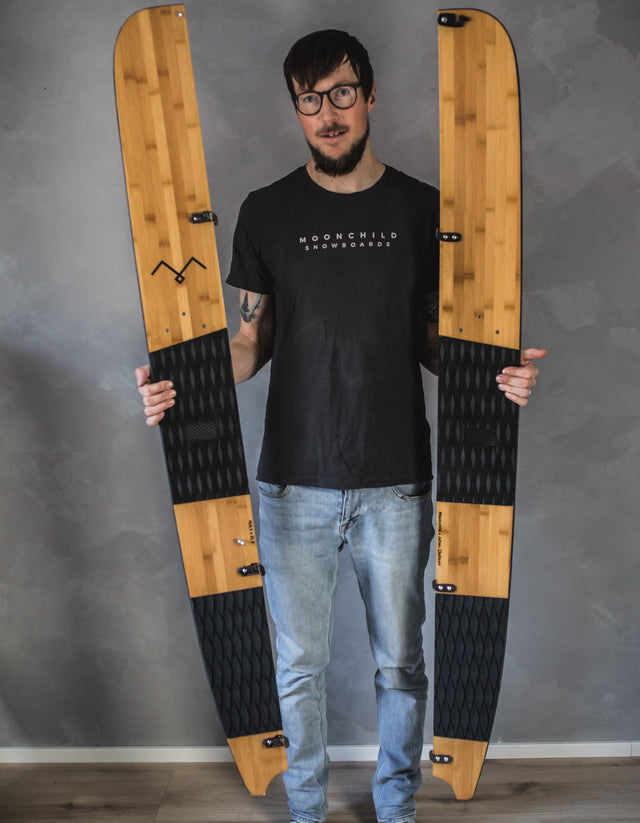10 Powsurfing Approaches: How to Earn Your Turns
Powsurfing approaches: How to earn your turns
Powsurfing—binding-free snowboarding—is about more than just the ride down. The big question is how to get to the top. Unlike traditional snowboarding, lifts aren’t always available, and different terrain requires different ways to reach your line.
From hiking in boots to splitsurfs, approach skis, snowshoes, or innovative hybrids, each method has its own pros and cons. Choosing the right approach not only saves you energy but also shapes the entire adventure.
Why effort matters
Like most of life’s greatest experiences, powsurfing comes with a little effort before the reward—and that’s part of what makes it so special. The climb sharpens your senses, the silence of the mountains fills you with anticipation, and the untouched slope above calls you higher. By the time you drop in, every turn feels sweeter, every spray bigger, and the ride itself more alive.
Sure, a helicopter drop on a powder-capped peak would be unforgettable. But the truth is, the runs you remember most are the ones you’ve earned yourself—what splitboarders call earning your turns.
The hike through deep snow is already a gift: fresh air, rhythm, and solitude. Yet it leads to something even greater—the surf-like freedom of powsurfing. With every step, anticipation builds.
Different powsurfing approaches
Depending on snow depth, terrain, and how much energy you want to spend, here are the main ways to reach your powsurf line.
1. Hiking in Boots
The simplest way to reach your line is to hike in your snowboard or powsurf boots.
-
Best for: shallow powder around 10–20 cm (4–8 inches) on backyard hills or short laps.
-
Advantages: quick and easy—no special gear needed, and you can reuse your bootpack for repeat runs.
-
Limitations: in deeper snow you’ll sink fast, burn energy, and can easily get stuck in heavy powder.
2. Splitsurfs or Hybrids
Splitsurfs function like splitboards, making them ideal for long tours, deep powder, and backcountry missions.
-
Best for: backcountry exploration, deeper snow, or tours lasting 30+ minutes.
-
Advantages: excellent float, efficient uphill travel with skins, and access to terrain beyond what boots or snowshoes can reach.
-
Limitations: transitions take time—adding or removing skins and reassembling the board—so they’re not ideal for quick laps.
Who’s making them?
Grassroots Powdersurfing pioneered splitsurfs in the late 2000s. At Moonchild Snowboards, we built a Johan Olofsson signature splitsurf in 2018 and are now developing the Atlas Hybrid at our Skunkworx division—a board that transforms between splitsurf and snowboard with bindings. Cardiff Snowcraft offers the Skiff - split-hybrid, and machinist Tylor Jarosz is creating innovative hybrid designs.
Most splitsurfers still use splitboard bindings, though they’re often overkill since highbacks aren’t essential. For the 25/26 season, Spark R&D released powsurfer heel loop that makes stowing bindings in your backpack easier. Some builders are experimenting with simple, lightweight touring bindings, showing there’s still plenty of room for innovation.
Picture: Johan Olofsson's signature powsurf
3. Approach Skis
Approach skis offer an efficient way to climb without the complexity of a full splitboard setup.
-
Best for: moderate ascents without the hassle of split transitions.
-
Advantages: no need to reassemble at the top.
-
Limitations: shorter than splitboards, so they sink more in deep snow. On the descent, they take up extra space on your back and must be strapped tightly.
Brands to watch: Union and Drift Boards make strong options, with Drift also developing simple bindings. Lope Snow Gear is working on a foldable model that could make approach skis much more practical.
4. Snowshoes
Snowshoes remain the most common choice among powsurfers.
-
Best for: short hikes (under 30 minutes), steep terrain, repeat laps.
-
Advantages: small, light, easy to pack, minimal transition—just unstrap and stow. Great for reusing a bootpack.
-
Limitations: less float than splits; in very deep powder, you’ll sink more.
Popular models: Verts are compact and highly effective for quick ascents.
At Moonchild Skunkworx, we created Moonwalkers—snowshoes that double as traction pads.
Picture: Moonwalkers – Traction pads / snowshoes

5. Hybrid Approach
For resort riders, a hybrid strategy combines ski lifts with hiking for maximum efficiency. Moonwalkers are ideal for this setup:
-
Ride the lift with your bindings on.
-
Hike farther into the side country in snowshoe mode with Moonwalkers.
-
Switch to traction pads, stow your bindings in your pack, and enjoy binding-free powsurfing.
This method saves energy, extends your range, and often returns you to the lift at the bottom—perfect for efficient, repeatable laps in both resort and sidecountry terrain.
Other Options
Motorized approaches—like catboarding, heli-drops, or snowmobiles—can reach incredible terrain, but they’re more expensive and not available to everyone.
Access often depends on location, permits, or guided operations, making them less practical for most riders.
If you’re one of the lucky few with access, it’s an amazing experience—but bringing snowshoes in your backpack is still recommended for extra freedom once you’re out there.
Final Thoughts
Whether you’re hiking in boots, using snowshoes, touring on splitsurfs, or exploring with approach skis, the best method is the one that keeps you safe, smiling, and riding more often.
Motorized options can be thrilling if you have access, but human-powered travel keeps powsurfing playful, accessible, and eco-friendly—true to the spirit of the ride.
FAQs About Powsurfing Approaches
Can I hike with a powsurf without special gear?
Yes! For shallow powder (4–8 inches / 10–20 cm), you can hike in boots alone. Longer or deeper climbs are easier with special gear.
What’s the best option for long tours?
Splitsurfs or hybrids with skins are the most efficient for deeper snow and big terrain.
Are snowshoes good for powsurfing?
Yes. Snowshoes are light, compact, and the best choice for short hikes or multiple laps in one zone.
They also work especially well on steeper terrain like couloirs, where splits can be less efficient.
What are Moonwalkers?
Moonwalkers, a Moonchild Skunkworx innovation, are snowshoes that transform into traction pads. They’re perfect for short to medium-length tours or hybrid approaches that combine lifts and hikes. Moonwalkers also let you switch your regular powder snowboard into powsurf instantly.



0 Comments
There are no comments for this article. Be the first one to leave a message!